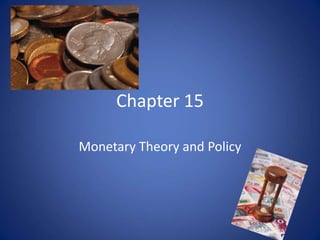
Chapter 15 monetary theory-and-policy
- 1. Chapter 15 Monetary Theory and Policy
- 2. The Demand for Money • Why would people hold money? – Transactions Demand for Money – Precautionary Demand for Money – Speculative Demand for Money
- 3. The Demand for Money Curve • The three motivates for holding money combine to create a demand for money curve. – Def: The demand for money curve represents the money people hold at different possible interest rates, ceteris paribus. – Why is it downward sloping? – Example of Graph
- 4. Example of a Graph
- 5. The Equilibrium Interest Rate • The supply of money is a vertical line (MS) implying that the quantity of money supplied is independent of the interest rate – Why? – Show equilibrium
- 7. What happens if the Fed increases the money supply? • The opportunity cost of holding money falls enough that the public is willing to hold the now larger stock of money
- 8. How the Fed Controls the MS? • The establishment of reserve requirements for banks • Buying and selling U.S. government securities and other financial assets in the open market • The volume of loans extended to banks and other institutions • The interest rate it pays banks on funds held as reserves
- 10. Recent Monetary Policy • Increase in the monetary base from $828 billion at mid-year 2008 to $1.63 trillion in early 2009 to more than $2 trillion in 2010. • Lower interest rates
- 13. Example of lowering the interest rate
- 14. Interest Rates and Investment • Suppose the Fed purchases U.S. government bonds. – What happens to Investment? – What happens to AD?
- 15. Example of Investment and Interest Rates
- 16. Adding the Short-Run Aggregate Supply Curve • For a given shift of the aggregate demand curve, the steeper the short-run aggregate supply curve, the smaller the increase in real GDP and the larger the increase in the price level.
- 17. Example of Graph of SRAS
- 18. The Monetarist View of the Role of Money • Def: Monetarism is the theory that changes in the money supply directly determine changes in prices, real GDP, and employment – They put the spotlight on the money supply. They argue that to predict the condition of the economy, you simply look at the money supply. – Too much money supply = higher inflation – Too less money supply= unemployment and deflation
- 19. The Equation of Exchange • Def: The equation of exchange is an accounting identity that state’s the MS time velocity of money is equal to total spending: MV=PY
- 20. The Quantity Theory of Money • It is assumed by classical economists that V and Y(real output) are fairly constant. – Why is this true? – Def: The Quantity Theory of Money states that changes in the money supply are directly related to changes in the affect of price level.
- 21. Modern Monetarism • Today, we do not think that V is constant and the employment does not always operate at full employment – M& P are correlated, but not perfectly correlated.
- 22. Targets Before 1982 • Between World War II and October 1979- the Fed attempted to stabilize interest rates. • Friedman said this made monetary policy a source of instability in the economy because changes in the money supply reinforced fluctuations in the economy. – He said pay less attention to interest rates and instead focus on a steady and predictable growth in the money supply – Monetary rule
- 23. Targets After 1982 • Less force on a steady and predictable growth in the money supply. • The force was on a targeted federal funds rate.